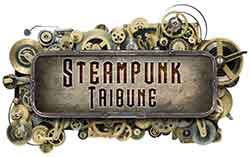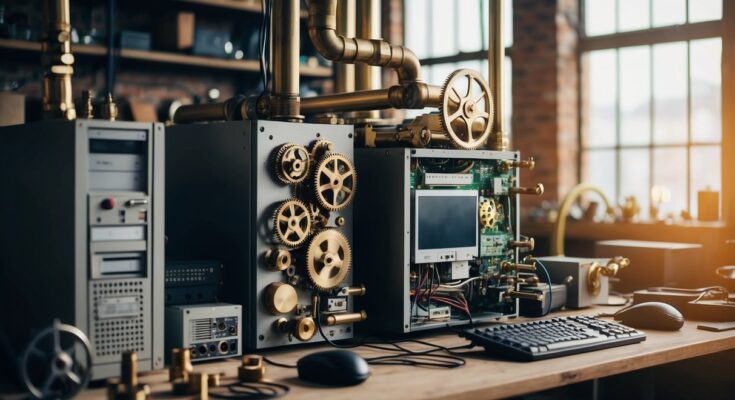Steampunk computer gear brilliantly merges the rich aesthetics of the Victorian era with the imaginative facets of science fiction. This unique blend captivates enthusiasts by converting modern technology into beautiful, functional works of art. By incorporating gears, brass, and leather into computer components, these creations offer an intriguing alternative to the standard tech design.

These devices not only serve a practical purpose but also act as a conversation piece, thanks to their unique and intricate craftsmanship. From keyboards that resemble old typewriters to fully customized computer towers adorned with metallic embellishments, each piece is a statement of individuality and creativity.
Enthusiasts find joy in the juxtaposition of 19th-century styles with contemporary technology, transforming ordinary gadgets into extraordinary steampunk masterpieces. This combination captures the essence of innovation, making steampunk computer gear a fascinating topic for both artists and tech lovers alike.
Historical and Cultural Context

Steampunk computer gear draws inspiration from the distinct styles and technological innovations of the 19th century. It combines Victorian-era aesthetics with the imaginative worlds of literature and fantasy, creating a unique blend of old and new.
Origins of Steampunk Aesthetic
The term “steampunk” emerged in the late 20th century, reflecting a combination of nostalgic and futuristic elements. It draws heavily from the 19th century, a period marked by rapid technological advancements and distinct aesthetics.
The aesthetic often incorporates brass, copper, and wood, evoking a sense of nostalgia for the craftsmanship of the past. Key figures in steampunk’s literary roots include Jules Verne and H.G. Wells, whose works depicted advanced technology through a Victorian lens. Their stories inspired the visual and thematic elements that define the steampunk genre, heavily influencing its use in modern computer gear design.
Victorian Era and the Industrial Revolution
The Victorian era and the Industrial Revolution were transformative periods in history. During this time, society witnessed a dramatic shift towards industrialization and mechanization. The fusion of elegance and utility characterized the design aesthetics of the era.
The widespread adoption of machines and innovations such as steam engines provided ample inspiration for the characteristic look of steampunk equipment. These historical developments created a rich tapestry of visuals and themes, which contemporary steampunk enthusiasts integrate into their creative projects, including computer gear. This aesthetic is a fusion of formality and function, resulting in a distinct visual style.
Influence of Literature and Fantasy
Literature and fantasy play central roles in shaping the steampunk narrative. Stories by authors like Jules Verne and H.G. Wells introduced fantastical machines and alternative histories. These tales provided a platform for reimagining technology in a more whimsical and imaginative setting.
Steampunk thrives in environments where fantastical elements blend with historical settings. By embracing fantasy, enthusiasts explore parallel worlds where steam powers everything from computers to airships. It also opens opportunities for creativity as makers and designers take inspiration from literary works to craft unique pieces of steampunk-themed technology, such as computer gear.
Designing Steampunk Computer Gear

Designing Steampunk computer gear requires a blend of artistry and technical skill, focusing on aesthetics that are both functional and vintage. Key aspects include the selection of materials like brass and copper, along with crafting techniques that highlight a 19th-century industrial vibe.
Steampunk Computer Design Principles
Steampunk computer design embodies the spirit of the Victorian era, characterized by its blend of nostalgia and innovation. Designers often incorporate metal elements such as gears, brass fittings, and copper accents to convey an industrial machinery-like feel. These elements are balanced with organic materials such as wood panels and leather straps, creating a harmonious yet intricate appearance.
Functional aesthetics are crucial. This involves using vintage gauges and antique light bulbs not just as decorative elements, but as functional parts of the device. Additionally, the design should capture the essence of a mechanical age, where visible workings, like rotating gears or copper wire connections, convey a narrative of complexity and ingenuity.
Selecting Materials and Elements
Material selection is critical in crafting Steampunk computer gear. Brass and copper are favored for their historical association with steam-powered machinery. Their warm metallic tones evoke the industrial era and provide durability. Wood panels serve as counterpoints to metal, offering a classic touch and texture.
Leather straps add both functionality and a touch of rugged elegance, evoking images of well-worn machinery. Decorative elements, such as vintage gauges and antique bulbs, contribute authenticity and elegance to the design. Incorporating copper wire can also enhance the visual complexity, allowing for both decorative and practical applications in the design.
Tools and Techniques for Crafting
Creating Steampunk computer gear involves a variety of tools and techniques. Basic tools include saws for cutting wood panels, screwdrivers for assembling metal fittings, and soldering irons for electrical components. More specialized tools, such as rotary tools, may be used for intricate detailing or modifications on metal and wood.
Techniques often include etching metal surfaces to add Victorian-style patterns or using patinas to give a weathered look to brass and copper elements. The crafting process combines both art and engineering, where each gear, screw, and wire is placed with precision to form a cohesive and operational design.
Essential Components of Steampunk PCs
Creating a Steampunk PC involves combining modern computer hardware with vintage aesthetics such as ornate brass fittings and antique designs. Key elements include suitable hardware that can be aesthetically modified, custom peripherals, and the creative incorporation of mechanical components like gears.
Core Hardware for Steampunk PCs
Building a Steampunk PC starts with selecting hardware that aligns with the style’s distinctive looks. The choice of a PC case is crucial, as it must allow for modification with features like brass panels or exposed gears. High-performance components are essential, but they must also be adaptable for aesthetic customization.
Fans and cooling systems should have visible mechanisms that echo the Steampunk theme. Internal components like motherboards and graphics cards can be painted or adorned with brass decorations for a cohesive look. Attention to internal lighting can enhance the visual impact, using LED strips to illuminate the intricate designs.
Custom Steampunk Peripherals
Peripherals are vital in emphasizing the Steampunk style. A steampunk keyboard might include vintage typewriter keys set into a brass frame, giving it an authentic feel. These keys can be crafted from materials like glass or metal to mimic typewriter aesthetics, offering both functionality and style.
Mice can feature leather accents or wooden casings, while monitors might be encased in brass with stand designs inspired by retro machines. Each component not only complements the central steampunk pc build but adds to the user’s immersive experience. Customization possibilities are endless, allowing for truly unique designs that reflect the creativity of the builder.
Integration of Clockwork and Gears
The use of gears and cogs is a defining characteristic of a Steampunk PC. These elements can be incorporated into the design both functionally and decoratively. For instance, gears can be added to the exterior of the case or integrated into the fans, creating a moving spectacle that embodies the mechanical aesthetics of Steampunk.
Clockwork mechanisms, even if non-functional, provide visual intrigue and capture the imagination. Builders can experiment with kinetic sculptures or static displays to achieve desired effects. Proper integration of these elements requires careful planning and a keen eye for detail to maintain functionality while enhancing visual appeal.
DIY Steampunk Workshops and Communities
Engaging in DIY steampunk workshops and communities offers enthusiasts an opportunity to explore creativity and connect with like-minded individuals. These gatherings provide avenues to learn new skills, share resources, and embrace self-expression. Online platforms facilitate collaboration and offer access to unique materials through specialized online stores like Etsy.
Organizing a Steampunk Workshop
Setting up a steampunk workshop begins with selecting a venue that accommodates hands-on activities. Libraries, community centers, and maker spaces are popular choices. Organizers should gather essential tools and materials, such as gears, cogs, and brass fittings. Clear instructions for projects help participants of all skill levels.
Inviting experienced facilitators enhances the experience by demonstrating techniques not easily learned from books. Workshops often involve creating items like modified keyboards or intricate jewelry. Partnerships with local Etsy shops can also provide unique materials and insights.
Promoting the event through local forums and social media can attract a vibrant group of attendees, fostering a creative and collaborative atmosphere.
Online Communities and Collaboration
Online communities dedicated to steampunk are thriving on platforms like Reddit and Facebook. These spaces enable enthusiasts to share ideas, tutorials, and experiences. Forums designed for specific interests, such as costume-making or gadget creation, offer tailored advice and inspiration.
Digital collaboration tools help participants work together on cross-country projects. They can share designs, troubleshoot problems, and celebrate completed works. Online stores, especially on Etsy, serve as valuable resources for unique materials unavailable locally.
Joining these communities allows individuals to refine their skills and broaden their network. These connections often transform into lifelong friendships centered around a shared passion for creativity and innovation.
Modern Techniques and Technology
Steampunk computer gear benefits from the fusion of modern techniques and technologies. By embracing advanced methods like 3D printing, creators can produce intricate designs, while the integration of traditional elements with new technology ensures a unique aesthetic.
Adapting 3D Printing for Steampunk Design
3D printing offers precise customization for steampunk aesthetics. Designers utilize 3D printing technology to create components that mimic vintage industrial textures, such as brass gears and intricate filigree. This method allows for experimentation with materials like PLA and metal-infused filaments.
Incorporating these prints into gaming keyboards, mice, and other peripherals adds a tactile quality. The process involves drafting models using CAD software, which is then transformed into tangible objects through layer-by-layer deposition. The accuracy of 3D printing empowers enthusiasts to execute complex designs otherwise difficult with traditional methods.
Interfacing Traditional and Advanced Technology
Combining traditional craftsmanship with modern technology is essential in steampunk computer gear. For instance, mechanical elements like rotary dials can be integrated with USB interfaces, bridging old-world charm and usability. High-quality leather and wood often accompany metallic components.
This blend necessitates careful electronic adaptation, ensuring that each piece operates effectively with digital devices. Techniques like laser cutting and CNC machining aid in achieving the necessary precision. The balance between traditional materials and current technological standards is vital for practical and aesthetically pleasing interfaces. By doing so, creators push the boundaries of both design and functionality in steampunk technology.
Steampunk in Fashion and Lifestyle
Steampunk merges historical elements with futuristic designs. It often features Victorian-era influences contrasted with modern and industrial components, offering rich avenues for self-expression.
Wearable Steampunk Accessories
Steampunk fashion features accessories that draw on Victorian aesthetics and mechanical motifs. Goggles, a signature item, often feature intricate details like brass or copper fittings. Pocket watches attached to waistcoats or leather straps add functional elegance, while top hats adorned with gears or feathers make bold statements.
Corsets paired with flowing skirts or tailored waistcoats give a nod to both tradition and innovation. Jewelry frequently incorporates clockwork and other mechanical components, reflecting both style and craftsmanship. Boots with decorative elements such as buckles or studs add flair. These accessories allow wearers to blend nostalgia with futuristic concepts.
Incorporating Steampunk in Daily Life
Infusing steampunk into daily life extends beyond clothing. Home decor can feature industrial lighting, like Edison bulbs, housed in brass fittings, or furniture with exposed gears and leather upholstery. Even mundane items, like laptop covers or mobile cases, can have steampunk influences, using wood and metal finishes to achieve the look.
Steampunk events and meetups provide opportunities for enthusiasts to showcase their style and explore other aspects of the lifestyle. Participants may attend conventions or gatherings where they can exchange ideas with like-minded individuals. This lifestyle invites creativity and offers various means of self-expression, blending the past and future into a coherent, uniquely personal aesthetic.
Gaming and Steampunk
Steampunk aesthetics often blend Victorian elements with modern gaming platforms. It offers gamers a chance to experience adventures set in worlds infused with steam-powered machinery. Integrating these themes provides a unique backdrop that draws players into immersive stories.
Steampunk Themes in Video Games
Video games harness steampunk motifs to create compelling narratives. Titles like Bioshock Infinite and Dishonored showcase Victorian-inspired worlds where technology and fantasy intertwine. These games often feature steam-powered devices and ornate machinery, embodying the characteristic ingenuity of the steampunk genre.
The visual style of these games often includes brass gears and copper piping, combined with a dark, atmospheric setting. This stylistic choice provides a distinct aesthetic that is instantly recognizable. Furthermore, the narrative often envelops players in an alternate history, offering a mix of exploration, adventure, and innovation.
Creating a Game Room with Steampunk Flair
Designing a steampunk-themed game room involves merging Victorian aesthetics with modern tech. Start with rich, warm colors like deep browns and burgundies to set the tone. Incorporate vintage furniture, metal accents, and industrial lighting fixtures to enhance the setting.
For technology integration, consider modifying gaming consoles with steampunk-inspired cases. Adding decor such as antique clocks, steam gauges, and leather-upholstered seating can further enhance the ambiance. These elements work together to create an environment where players can fully immerse themselves in the steampunk theme.
By focusing on these elements, it’s possible to transform a regular gaming space into a unique steampunk haven, making each gaming session an adventure in itself.
Final Thoughts
Steampunk computer gear embodies a unique blend of Victorian-era design with modern technology. This aesthetic choice allows users to transform their tech environments into something visually intriguing. Brass, wood, and leather elements are common, adding a touch of nostalgia to the functional world of computing.
For many, this style is not just about appearance; it’s a form of self-expression. By integrating mechanical components and intricate designs, users impart a distinct personality to their gear. This artistic modification turns everyday items into conversation pieces.
While it may not be mainstream, the steampunk aesthetic continues to attract a dedicated following. Users appreciate the craftsmanship involved in creating these devices and often feel a connection to a bygone era. This connection resonates with those who value both history and innovation.
Below is a simple comparison of steampunk gear elements:
| Element | Material | Purpose |
|---|---|---|
| Case | Brass/Wood | Encloses components |
| Keyboard Keys | Mechanical | Enhanced tactile feel |
| Monitor Frame | Copper/Leather | Nostalgic display unit |
Steampunk computer gear remains a testament to blending artistry with practicality. Its appeal lies in its ability to evoke feelings of nostalgia while serving modern needs. For those who appreciate craftsmanship and distinctiveness, steampunk gear offers a captivating alternative to standard tech aesthetics.




